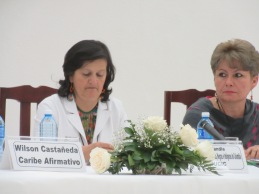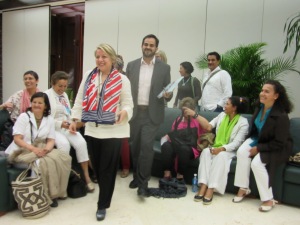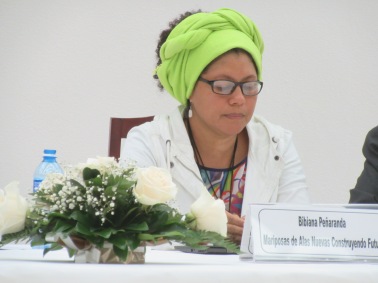Havana, Cuba
February 16, 2015
On Thursday, Feb. 12, the latest cycle of peace talks between the government of Colombia and the FARC in Havana came to a close after 10 days of discussions that focused on the final two substantive items on the agenda — victims and the end of the conflict. I was in Havana doing research on the peace process and had the opportunity to talk with the parties and to attend a number of related events.

The government delegation awaits the presentation of the report by the Historical Commission on the Conflict and Its Victims. (Photo by Bouvier).
Visiting Havana, one can’t help but be impressed by the seriousness of the process, the commitment of both parties to finding solutions to end the conflict, and the climate of dialogue and engagement that has been created between the Colombian government and the Revolutionary Armed Forces of Colombia. The kind of mutual respect, active listening, consideration, and give-and-take between the parties–at the service of ending the conflict once and for all–that is occurring in Havana provides a model for what is needed in Colombia. Gerson Arias, from the Office of the High Commissioner for Peace, told me that in earlier peace processes, each side came armed with its own list of agenda items. This time around, he said, the parties put aside their individual agendas to start fresh in the creation of a common agenda, and they defined a framework agreement with an agenda they believed would be possible to complete, and an explicit commitment to ending the conflict. This new approach seems to be yielding positive results that could be seen in the latest round of discussions in Havana.
 In the 32nd round, reports by the historical commission on the conflict and its violence, the sub commission on gender, and the technical sub commission on ending the conflict show that the talks continue to make steady progress. In addition, in this round, the parties received representatives of women’s and LGBTI (lesbian, gay, bisexual, transgender and inter-sex) organizations, and the FARC announced that it would stop recruiting youth under 17 years of age. Finally, leaders of Colombia’s leftist alliance known as the Broad Front for Peace visited Havana to discuss the monitoring and verification of the FARC’s unilateral ceasefire, which began on Dec. 20, 2014, and the FARC announced that it would continue to uphold the ceasefire. (See the Broad Front’s last monitoring report on the ceasefire here).
In the 32nd round, reports by the historical commission on the conflict and its violence, the sub commission on gender, and the technical sub commission on ending the conflict show that the talks continue to make steady progress. In addition, in this round, the parties received representatives of women’s and LGBTI (lesbian, gay, bisexual, transgender and inter-sex) organizations, and the FARC announced that it would stop recruiting youth under 17 years of age. Finally, leaders of Colombia’s leftist alliance known as the Broad Front for Peace visited Havana to discuss the monitoring and verification of the FARC’s unilateral ceasefire, which began on Dec. 20, 2014, and the FARC announced that it would continue to uphold the ceasefire. (See the Broad Front’s last monitoring report on the ceasefire here).
Historical Commission on the Conflict and its Victims

Historical Commission on the Conflict and Its Victims presents its report to the peace table in Havana. (Photo by Bouvier).
On Tuesday morning, Feb. 10, the 12 commissioners and 2 rapporteurs of the Historical Commission on the Conflict and its Victims (HCCV) presented their long-awaited reports to the negotiating teams in Havana. (Click here for a list of the commissioners.) Later that day, Eduardo Pizarro and Víctor Manuel Moncayo, the two rapporteurs, presented an overview of the commission’s work at a press conference at the Hotel Occidental in the Miramar section of Havana.
View the press conference here:
The reports of the commission address the topics mandated by the Colombian government and FARC delegates to the peace table last August, namely:
- the origins and causes of the conflict,
- the factors accounting for the persistence of the conflict, and
- the impacts of the conflict on the population.
The rapporteurs were charged with synthesizing the reports and producing a final report on the areas of consensus and disagreement they found therein. It proved impossible within the four-month time frame assigned (later extended to six months) for the two rapporteurs to reconcile the twelve reports and produce a single common narrative. Instead, the rapporteurs each produced their own additional report. (Download the final reports here.)
The Historical Commission on the Conflict and its Victims is the thirteenth commission on the Colombian violence established since 1958. Nonetheless, it is unprecedented in a number of ways. It is the first such commission to be established jointly by two parties at a negotiating table as part of a peace process. Unlike a truth commission, it was established in the midst of the conflict, without benefit of any prior peace accord. Construction of trust has proven difficult but not impossible in this context, and appears to have been more successful in Havana than in Colombia, where the ongoing war continues to generate skepticism and polarization about the process, as well as growing efforts to dialogue and find convergences.
Secondly, the mandate of the HCCV is unique. Truth commissions are often established after peace accords are signed as a measure of symbolic reparations and fulfillment of the victims’ right to truth. The primary purpose of the HCCV was to help the negotiating teams define the nature of conflict violence in order to craft better agreements to address the rights of the victims. Implicitly, the process was also expected to shape the political context within which a final peace accord could be reached. A better understanding of the complexity of conflict violence necessarily broadens the scope of discussion beyond the FARC to analyze the full range of all of the state and non-state actors that bear responsibility for the conflict and its perpetuation. This re-positioning of the FARC as one of numerous actors with responsibility for the conflict and its perpetuation should open the possibilities for new agreements, and greater measures of truth, justice, and reparations for a larger number of victims.
Third, both the process and participants engaged in the HCCV were unique. While truth commissions generally entail extensive participation of and testimony by victims of the conflict, often with some benefits from a cathartic process, the HCCV did not engage or seek to engage victims as part of its process. Instead, the HCCV was designed as a vehicle for independent academics to provide their objective assessments of the conflict based not on new research but on their accumulated knowledge and prior research on the Colombian conflict. (See the profiles of the commissioners here.) While victims might be expected to benefit from the findings in the reports, or the particular recommendations that might be generated, Colombian victims were the audience, not the agents, of the HCCV process.
Clearly, there is and will be no “official story” of the conflict. The reports reflect the conflict in all its complexity, the multiplicity of interpretations to which this complexity has given rise, and the infinity of responsibilities yet to be assigned. The reports should help the parties move forward in drafting the chapter on victims for the final accord and defining responsibilities, reparations, and guarantees that the violence of the conflict will not be renewed. The HCCV may also provide analysis and data that could serve as inputs for a future truth commission.
Both sides expressed pleasure at the process and in the results. The expectation is that these reports will pave the way for further dialogue and truth-telling, and will open a national dialogue in Colombia about the causes and consequences of violence, and the ways to prevent it. As María Emma Wills, the sole woman on the Commission, told me, “The way out is through the recognition of the gray areas.” (La salida se da por el reconocimiento de los grises.)
There will be much intellectual and emotional work needed to break through the polarization of positions, and the work of the HCCV should help give momentum to this process. (For a more detailed analysis of the content of the report, click here.)
Peace Commissioners Receive Women and LGBTI Representatives
On Wed., Feb. 11, the peace teams of the government and the FARC re-convened at El Laguito, a high-security complex of diplomatic residences in Havana, where they heard testimonies from the heads of five Colombian women’s organizations and one organization that works for the rights of lesbian, gay, bisexual, transsexual and intersexual (LGBTI) persons.
The delegation was the second in an anticipated series of three delegations to Havana organized by the Sub commission on Gender. (The press conference from the first delegation in December 2014 has been newly posted here.) This session’s delegation included:

Nelly Velandia, ANMUSIC, and Ruby Castaño, Coordinación Nacional de Desplazados. (Photo by Bouvier).
- Nelly Velandia, Association of Peasant, Afro-Colombian, and Indigenous Women (ANMUCIC);
- Ruby Alba Castaño, the Women’s Department of the National Coordinator for the Displaced
- Fatima Muriel, the Weavers of Life Alliance, Department of Putumayo;
- Bibiana Peñaranda, “Butterflies with Wings” network;
- María Eugenia Vásquez, National Network of Women ExCombatants of the Insurgency;
- Wilson Castañeda, of the Affirmative Caribbean Corporation.

María Eugenia Vásquez, Red Nacional de Mujeres Ex Combatientes de la Insurgencia. (Photo by Bouvier).

Belén Sanz, head of UN-Women-Colombia (Photo by Bouvier).
On Wed. afternoon, the delegation held a working session with the sub commission on gender chaired by María Paulina Riveros for the Colombian government and Commander Victoria Sandino for the FARC. They were accompanied by international gender experts Belén Sanz (head of UN-Women in Colombia), Magalys Arocha, Hilde Salvesen, and María Emma Wills.

Members of the Gender sub commission after the press conference with the Colombian delegation of women and LGBTI leaders.
Later in the day, the delegation held a press conference and urged the parties at the peace table to consider a bilateral ceasefire. They called on the Santos government to declare an indefinite truce and to accelerate talks with the ELN and the EPL insurgencies.
Read the delegation’s communiqué here and view their press conference here:
Technical Sub Commission
In a joint communiqué on Feb. 12, the delegations of the Colombian government and the FARC announced that they had reached agreement on the guidelines and rules for the technical subcommission on ending the conflict. (Read the guidelines here.) The subcommission (see its members here) is charged with analyzing experiences and generating initiatives and proposals on the bilateral ceasefire and the setting aside of arms. It will be receiving experts on these topics when it meets on Feb. 27 in the next round of talks, which starts on Feb. 23.
On Fri., Feb. 14, Colombian government negotiators on the Technical Subcommission joined members of the Colombian military high command and dozens of high-level officials for their own high-level meeting in Cartagena. There they listened to international experts on DDR (disarmament, demobilization and reintegration) from Nepal, El Salvador, Northern Ireland, among others. (See Semana’s analysis of the meeting here.)
The new guidelines recently established for the technical sub commission also make provisions for creating whatever mechanisms might be necessary to consider the other themes which the 2012 framework agreement identified as integral to the “end of the conflict.” These topics include:
- Guarantees for the reincorporation of the FARC-EP into economic, social and political aspects of civil life, according to their interests;
- The review of the situation of persons deprived of liberty, accused or condemned for belonging to or collaborating with the FARC-EP;
- Intensifying the fight against criminal organizations and their support networks, including the fight against corruption and impunity;
- The review, reform, and institutional modifications necessary to confront the challenges of peacebuilding;
- Security guarantees; and
- The clarification of the phenomenon of paramilitarism, among others.
FARC Announces End to Recruitment of Minors Under 17 Years Old
In a press conference on Thurs., Feb. 12, the FARC-EP peace delegation announced that the FARC would unilaterally cease recruiting youths under 17 years old. View their announcement here:
The announcement created a mixed reaction. The gesture was seen by many as an important step toward de-escalating the conflict. It clearly responded to growing demands from civil society groups for the insurgencies to stop child recruitment. It was symbolic in that it was made on the fourteenth anniversary of the enactment of the Protocol for the Convention on the Rights of the Child. Yet many questioned why the FARC was stopping at age 17 and what would happen with the child soldiers already in the FARC ranks.
President Juan Manuel Santos noted that his government “valued” the FARC’s gesture as “a step in the right direction,” but that it was “insufficient,” considering that the established age for minors is 18 years of age. “I don’t understand why they stopped half way,” he said. (See Santos’s statement here.)
In discussions with the FARC leadership following the press conference at the Palacio de Convenciones on Thursday morning, FARC commander Iván Márquez had predicted that their gesture would be considered insufficient. “Everyone always wants more,” he said. “But we need gestures from the government too.” I asked what kind of gestures they wanted. “We want them to respect conscientious objectors and to stop the ‘batidas,'” he told me, referring to a recruitment practice the Colombian military have used in poor neighborhoods, and “to stop using minors under 15 years old to infiltrate the guerrilla.” (Read the FARC press statement here.)
The gestures requested by the FARC echo some of the demands of civil society as well. A recent decision by the Constitutional Court of Colombia ordered the Army to resolve the situation of Reinaldo Aguirre, a conscientious objector who has been accompanied by the Mennonite organization, Justapaz. (See the Court finding T-455-14 here.) The sentence constitutes an important advance and sets a precedent for the recognition of youth who wish to exercise their rights for reasons of conscience (C.O. status) and avoid obligatory military service. (Read the Justapaz press release on this topic here.)
Final Observations
Some parties in Havana privately expressed frustration that the visits last year of the five delegations of victims and the visits of representatives of women’s and LGBTI groups have delayed progress on reaching agreement on the final points of the agenda. Yet such visits play a critical role in ensuring that the peace process will be brought to a successful conclusion and that peace accords will lead to sustainable peace. First, it is no secret that there is a disconnect between the advances being made in Cuba and the skepticism reigning in Colombia. The visits of the victims, like those of the women’s and LGBTI organizations, can help to bridge this divide and give civil society a greater stake in the process. These visits also constitute symbolic collective reparations to groups that have faced historical exclusion, discrimination, and persecution. In addition, such visits are an important investment in the future. The communities and networks the delegates represent are critical multipliers in educating the public and generating support for the peace process. The more they know about the process, the better able they will be shore up support for it, and the more effectively they will be able to assist with the ratification process and the implementation of any agreements reached.




Mis saludos y felicitaciones a Maria Emma Wills
LikeLike
Congratulations that is a very well built an didactically focus report. My great concern is the isue of justice. The crimes against humanity and international human rights violations should be studied, judged and punished. And that should be done to prevent repetition and to give legal guarantees to the farc members. To ensure that the status they will be granted in an eventual peace agreement will be kept in the years to come. It is important to point out that was not the case with ” la ley de punto final ” in Argentina that was reverted some years later and is important to underline that the word is different after the creation of the international criminal court. In short, saying to Farc that no persecution will be carried out is a lay because sunner or later such a measure will be reversed. It will much better for the stability of the agreement and for the legal security of farc to planning for its leders and high rank members some penalties in line with the ( ouregiously short) 8 year punishement negotiated and imposed to the extreme right wind insurgency a decade ago. The contrary is to pave the way to repetition of conflict, vengeance and violence
LikeLike
Very important points and well said. Thanks. Ginny
LikeLike
Ginnie
Excelente tu nota.
Gracias por el envio y saludos
Luis Maira
LikeLike
Gracias. Un placer conectar de nuevo después de tantos años. Tengo mi libro para ti y para Raúl–?lo prefieres en español o en inglés y dónde se los mando? Abrazo, Ginny
LikeLike
Luis–Me puedes mandar la dirección a mi correo: vbouvier@usip.org. Saludos, Ginny
LikeLike
Gracias, Ginny por tan preciso, didáctico y completo reporte. Tu publicación permite se amplíe la comprensión de tan complejo pero esperanzador proceso. Saludos.
Raúl Vergara Meneses
LikeLike
Pingback: Salaam and Paz - the word for peace is women - TransConflict
Pingback: Vicissitudes of a Peace Process: 36th Round of Talks Closes with Parties on Track | COLOMBIA CALLS